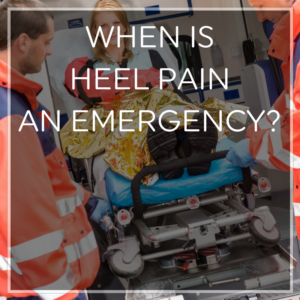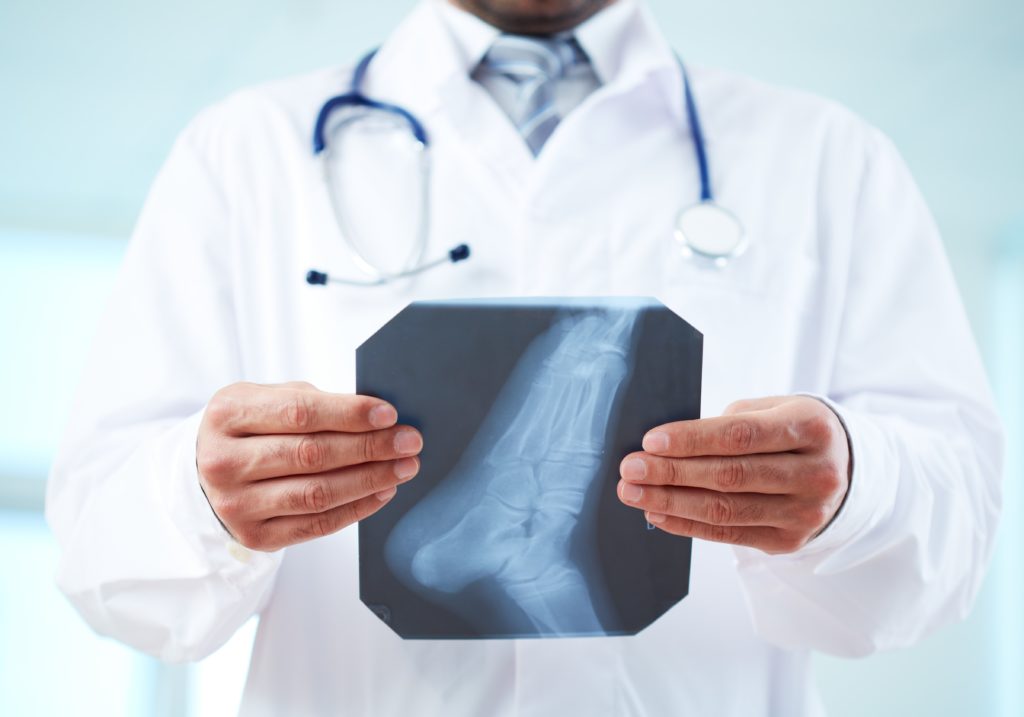 Heel pain can be extreme in many situations–there’s no question about that.
Heel pain can be extreme in many situations–there’s no question about that.
But it’s not always simple or easy to decide whether your level of pain requires at-home treatment, a trip to the doctor, a visit to urgent care, or a trip to the emergency room.
When severe pain strikes, how can you decide whether your situation warrants a trip to the emergency room versus urgent care or your family doctor?
The following guidelines can be helpful in deciding your best course of action for quick relief and long-term healing:
When to Visit the Doctor for Heel Pain
Typically, your primary care physician or podiatrist is your best bet for treating severe heel pain that doesn’t require an emergency room visit (more about that below!). If you’re experiencing any of the following symptoms, it’s important to schedule a visit with your doctor right away:
- Heel pain that doesn’t respond to conservative at-home treatments for plantar fasciitis like icing, orthotic inserts, rest, and stretching
- Heel pain and foot pain that suddenly becomes worse
- Numbness in your feet or heels
- Pain even while you aren’t putting weight on your feet and heels
Depending on your diagnosis and unique situation, your doctor may still decide to refer you to a hospital or recommend surgery. But if your situation is ongoing and can wait just a few hours or even a day or two, it’s a good idea to start with the professional who knows your health history best. And don’t be deterred by previous wait times: Even if you’ve previously had to wait a couple of weeks for an appointment with your doctor or podiatrist, call anyway and explain what’s going on. Most doctors will make room in their schedule based on the severity of your symptoms, especially if you are a current patient.
When in doubt as to whether your situation needs to be addressed immediately at an urgent care or in the emergency room, call a 24/7 nurse hotline (most insurance networks and hospital networks provide this free service).
Cost/Benefit: A standard doctor’s office visit is likely to be your least expensive option for dealing with severe heel pain with a standard copay or out-of-pocket payment; however, it’s not usually the most immediate solution.
When to Visit Urgent Care for Heel Pain

Urgent care clinics exist primarily to fill the gap when your doctor’s office is closed for the day, and you need to be seen immediately. If your heel pain increases in severity or you are concerned about the onset of new symptoms alongside your heel pain, but aren’t certain you have an emergency on your hands, urgent care is a good choice.
At urgent care, you may be given pain medication or other treatments to manage your condition until you can be seen by your primary care provider. Urgent care providers are also trained to determine whether a situation is severe enough that you need medical treatment in a hospital setting immediately. If your situation does merit a true emergency, you’ll be referred to an emergency room immediately. However, if your situation doesn’t merit emergency treatment, you’ll have peace of mind knowing that your condition isn’t likely to deteriorate by waiting for your primary care physician’s office to open.
Urgent care facilities can often perform simple x-rays, but are not equipped to offer on-the-spot surgery.
If you’re experiencing any of the following symptoms, get to your doctor (if the office is open) or urgent care (if your doctor is not available) right away:
- An increase in heel pain severity accompanied, by a fever
- Severe inflammation in the heel and foot area with red streaks spreading away from the area
- Heel pain that suddenly gets much worse
Cost/Benefit: The cost of an urgent care clinic will typically be higher than your doctor’s office copay or out-of-pocket expense, but not by much. Expect to pay approximately twice what you might pay for a standard doctor’s visit for the benefit of after-hours service.
When to Visit the Emergency Room for Heel Pain

In general, the emergency room is the right choice if your situation feels like “every minute counts” in how quickly the symptoms have onset, how quickly your condition is deteriorating, or how likely failure to treat your symptoms might result in permanent damage or disability.
The emergency room is equipped to handle situations that must be resolved quickly and immediately, can’t wait for a primary care provider’s diagnosis, might require immediate surgery or medical intervention, or might result in dire consequences if left untreated.
It’s important to remember that ER doctors are experts in putting the brakes on an emergency, not providing specialized foot care. If your symptoms don’t require emergency treatment, it’s highly likely that you’ll be referred to a specialist who can help you treat your condition effectively. However, if you experience any of the following symptoms the ER may be the right choice:
- Lacerations of the heel or foot with heavy bleeding
- A suspected torn Achilles tendon, marked by a popping sound in the heel or foot, followed by severe pain and inability to bear weight
- Sudden inability to move or bear weight on the heel or foot, accompanied by fever, chills, and nausea
- A diagnosis of diabetes accompanied by a laceration or injury to the heel that is inflamed, warm to the touch, or worsening in severity
- Signs of a stress fracture (which may break completely if not addressed quickly) or broken bone in the heel or foot: inability to bear weight, swelling, and extreme pain
Cost/Benefit: The emergency room is almost certainly the most expensive option available, easily running into the thousand-dollar range for the visit alone. However, in a true emergency it’s an invaluable resource to avoid permanent damage or serious consequences for your health.
When in doubt, trust your instincts and err on the side of your health. If you’re feeling conflicted about what to do in your unique situation, don’t be afraid to call your doctor’s office, the urgent care facility, or the 24-7 nurse hotline before you make the trip. When you’re in pain, it can be especially difficult to make a decision that will impact not only your pain level but your finances.
Take a few minutes to rest, breathe deeply, and evaluate the situation. Then consider the information above, talk to a live medical professional, and seek the help you need. No matter what your level of pain, “grin and bear it” shouldn’t be among the options you consider. Pain is your body’s way of alerting you to a serious situation that needs to be addressed–and the more acute and sudden the onset of the pain, the more aggressively your body is trying to relay the message that serious damage may be occurring.




I am comsidering fascia release surgery after suffering for 19 months with PF in both feet with arthritis. I’ve tried everything but am still in pain, barely able to walk. Has anyone had this surgery who can talk about?
Hi Gay 🙂 We’ve got several resources for you! First, you can visit this blog post where we interviewed a customer who had surgery: https://heelthatpain.com/plantar-fasciitis-surgery-story/
You can also join our Facebook community, where some members have already had surgery. You can use the search feature to find past discussions about surgery, or ask a question and our community members will reply and share their experiences:
https://www.facebook.com/groups/HeelPainSupportCommunity/
Hi my name isYvonne,
My left foot has been giving me problems for years and now I walk practically with a limp . My foot is in constant pain., as my work is a standing up job and loads of walking around. I can’t sit down at work as I’m a machinist and you need to be on your feet for that . It’s full time 38 hour week with one half an hour break every day. Even at home my foots painful.
Please can someone tell which cases would be considered, an emergency , at times I find it very difficult to stand up.
Hi I am a diabetic, and lately I have been getting arch pain that starts out mild then gets worse and it last for a day or two. It feels like someone is stabbing me in my foot with a hot knife. It is in the arch area under the ankle bone close to the outside of my arch. It causes me not to be able to walk on it very good and the pain comes in waves. Massaging or rolling it on something or soaking it does not help it. It comes any time of day or wakes me up at night. I do not stand all day I mostly sit. Could this be plantars fasciitis or something else